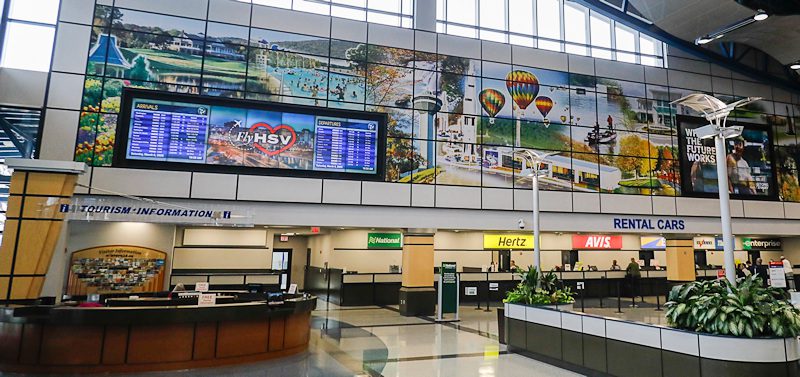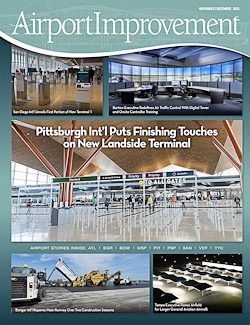As passenger traffic at Huntsville International Airport (HSV) grew steadily in recent years, officials realized they had an issue that had to be addressed. Signage at the Alabama airport was making it difficult for passengers to navigate through the facility.
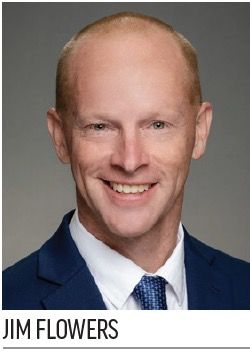 “There was a big need for this,” states Jim Flowers, chief design and construction officer at HSV. “Over the years, we did a few projects that impacted wayfinding. However, some of our oldest signs are 35 years old and became more difficult to maintain. They no longer serve our passengers well.”
“There was a big need for this,” states Jim Flowers, chief design and construction officer at HSV. “Over the years, we did a few projects that impacted wayfinding. However, some of our oldest signs are 35 years old and became more difficult to maintain. They no longer serve our passengers well.”
Instead of making piecemeal improvements, management decided to start from scratch and revamp all airport signage for better consistency—from approach roads and curbside areas to the terminal, gates and parking garage.
With funding approval from the Huntsville-Madison County Airport Authority, the airport hired Gresham Smith to develop a comprehensive master plan for wayfinding and signage. Plan development spanned April 2024 to April 2025, and the Authority approved the plan in May 2025.
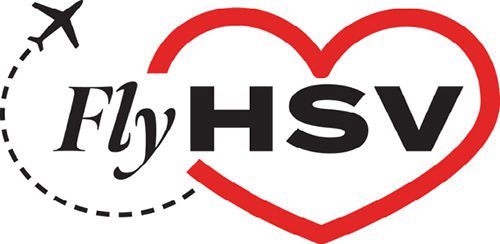 facts&figures facts&figures
Project: Wayfinding & Signage Master Plan Location: 2024 Operations: 1.64 million Cost: $1.3 million for master plan, design & preliminary construction; $1 million for final construction Funding: FAA Grants Master Plan Development: April 2024-April 2025 Remaining Timeline: Final design details & initial construction fall 2025-early 2026; remaining construction scheduled to start mid-2026 Master Plan & Design: Gresham Smith Virtual Display Subconsultant: Arora Engineers Key Benefits: Establishing comprehensive plan to improve wayfinding for passengers; new signage, lighting & virtual displays will brighten & modernize terminal; improved signage for curbside, garage & airport roads will increase efficiency and cost-effectiveness; minimizing risks |
Gresham Smith began its process with a wayfinding assessment of the entire airport. “We spent two days walking the airport to familiarize ourselves with passenger flow and identify problem areas,” says David Park, the firm’s senior environmental and graphic designer. “Then, our design team held several meetings with key stakeholders from the airport. Each department, including Executive, Marketing, Security, IT and others identified wayfinding issues that were not readily apparent during the site walk, and were able to provide customer comments. This initial assessment took us three months.”
Blueprint for Improvements
The following is an abbreviated list of issues identified:
- Overhead roadway signs for vehicles have reflective messaging and borders, but the backgrounds are nonreflective. This makes them less conspicuous and harder to read at night.
- When motorists approach the parking ticket plaza, they don’t have enough time or information to make price-based decisions about their various parking options.
- Garage signage is not sufficient for helping drivers remember where they parked.
- Vertical transitions inside the terminal are not well marked, making it difficult for passengers to easily identify the correct path.
- There are too many signs in the concourse; some list secondary destinations that do not need to be included.
Flowers considers the full list to be one of the most valuable parts of the master plan Gresham Smith created for the airport. “We now have a blueprint to improve several areas within our signage and wayfinding system,” he explains.
Funding and Execution
The airport is tackling its goal of improving wayfinding for customers in three stages: master plan development, which is already complete; final design details and initial construction, occurring this fall and early next year; and final construction, which is expected to start in mid-2026.
The first two stages are being funded with a $1.3 million grant from the FAA. The airport plans to apply for another $1 million FAA grant to pay for final construction.
Big Vision, Small Details
The new graphic style Gresham Smith recommended for signage was guided by visioning exercises it conducted with airport staff. During these sessions, employees highlighted the U.S. Space and Rocket Center in Huntsville and a strong high-tech industry presence throughout the region as important factors in the airport’s personality/culture. The consultant then presented three options, and HSV management selected the graphic theme that visually hinted at a solar eclipse and rocket engine nozzle, which became known as “the spotlight.”
 In subsequent meetings, stakeholders got a preview of sign details, such as sizes, fonts, kerning and colors. “After designing a basic family of signs for each area of the airport, we overlaid them on photos and created before/after passenger journey sequences so that airport officials would know exactly how they would look,” Park says.
In subsequent meetings, stakeholders got a preview of sign details, such as sizes, fonts, kerning and colors. “After designing a basic family of signs for each area of the airport, we overlaid them on photos and created before/after passenger journey sequences so that airport officials would know exactly how they would look,” Park says.
To reinforce the need for improvement, the consultant showed airport staff examples of existing signage that is confusing. “We were using different symbols for the same thing, such as nursing stations and handicapped signs,” Flowers laments.
Next, the design team leveraged Gresham Smith’s experience at other airports and applied a set of guiding principles the firm has developed over the years to specific wayfinding issues in all public areas at HSV. Key objectives were providing solutions that will ultimately enhance customer safety and providing information to customers in an easily digestible format, exactly when and where they need it. Park notes that when changes are implemented, passengers will be equipped with the knowledge they need to enjoy a more efficient and less stressful experience throughout each segment of their journey.
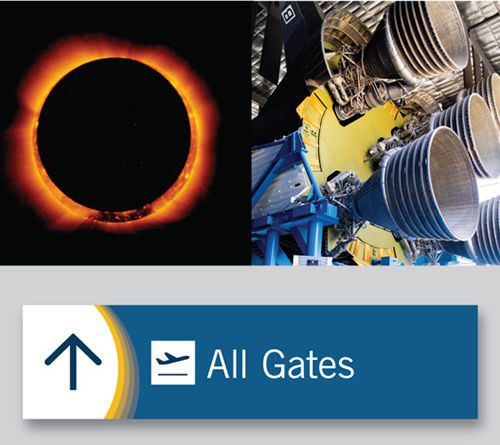
Aerospace images provided inspiration for the new signage design.
Foundational Strategies
The consultant’s design and wayfinding team was guided by an Airport Cooperative Research Program (ACRP) survey of 1,000 international travelers that highlights the importance of visual, verbal and virtual communication. Respondents ranked static signage, landmarks and intuitive building layouts (visual elements) as the most important aspect of wayfinding, followed by direct communication with staff (verbal). The third-most import factor (virtual) starts before travelers arrive at the airport, with social media and pre-trip planning on the airport website, and continues onsite with check-in kiosks, flight information displays and dynamic/interactive signage.
When advising HSV, Gresham Smith underscored the need for coordination and collaboration among airport groups responsible for the various communication methods: The Wayfinding Committee for visual elements; airport staff and Information Desk volunteers for verbal communication; and multiple airport departments for virtual communication via touchscreen displays, dynamic information boards/video walls, website content and social media channels.
The airport’s subject-specific master plan also emphasizes the “four Cs of wayfinding”:
Continuity – Park explains that each decision point for guests is essentially a link in the airport’s wayfinding chain. If guests reach a decision point and the information they need is missing or unclear, the wayfinding chain is broken. This can cause confusion and undermine confidence in the rest of the wayfinding system, he adds.
Connectivity – Airport wayfinding and signage systems are also analogous to a spider web, where every strand of the web is connected. Gresham Smith encouraged HSV to consider how making changes to one part of its wayfinding system will affect the rest of the system.
Confirmation – Identification signage helps assure guests that they have arrived at their desired destinations within the airport. Pairing each directional sign with a corresponding identification sign is an underlying strategy in the HSV plan.
Consistency – Park emphasizes that consistency is the backbone for all aspects of wayfinding. From the moment passengers enter the airport until they board their plane, information must be on target and presented in a consistent manner. This applies to spoken words, written directions/signage, and content on the HSV website and other virtual systems.
Together, the four Cs are fundamental principles for delivering the right information at the right place.
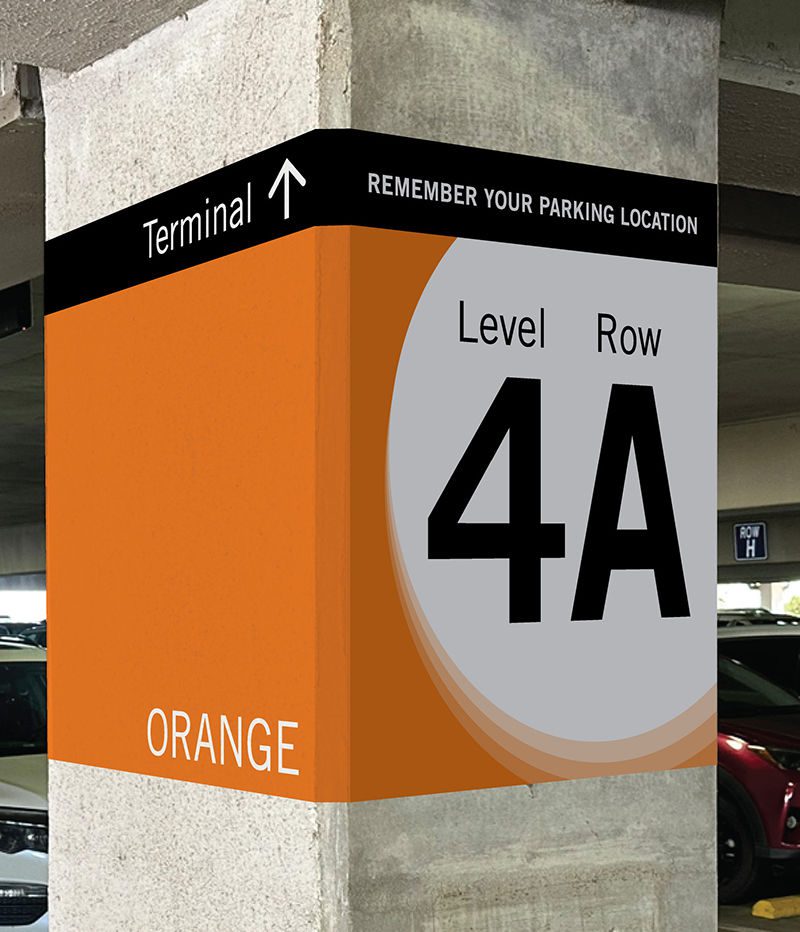
New garage signage was one of several improvements recommended by Gresham Smith.
The Dominance of Digital
Like many other airports, HSV uses digital displays to deliver frequently changing information in real time. Park notes that building such elements into the wayfinding system provides HSV with operational flexibility that delivers a high level of service to
its customers.
The consultant suggests using digital systems for content such as the location of concessions on maps, and rotating airline positions in the ticketing lobby or curbside. “Customers seeking information that requires frequent updates are more likely to trust the information coming from a digital source,” he adds.
Determining the preferred display technology for specific space—LCD flat panels or direct view LEDs (DVLED)—is a big part of the digital strategy at HSV. Park explains that LCD flat panel displays are preferred when high resolution is required for up-close viewing, while large-format video walls that will be viewed from a distance are better served by DVLED technology. In general, large displays can have a dramatic visual impact; at HSV, they also help reflect the region’s high-tech industries.
Not surprisingly, the airport uses a mix of both types. The flexibility of digital systems allows it to communicate crucial information inside the terminal, at the curbside, along roadways and in the parking garage.
 Arora Engineers worked as a subconsultant of Gresham Smith on the coordination and design of HSV’s digital display strategy. “We examined passenger flow and potential congestion points, and then offered guidance,” says Heath Kolman, vice president of the Special System Practice for Arora. “We reviewed all the displays in the terminal as well as curbside, the parking garage and entrance roads. Then we made suggestions on what types of monitors should be used, and where to put them.”
Arora Engineers worked as a subconsultant of Gresham Smith on the coordination and design of HSV’s digital display strategy. “We examined passenger flow and potential congestion points, and then offered guidance,” says Heath Kolman, vice president of the Special System Practice for Arora. “We reviewed all the displays in the terminal as well as curbside, the parking garage and entrance roads. Then we made suggestions on what types of monitors should be used, and where to put them.”
Naturally, the project required close collaboration with HSV’s Information Technology staff. “In most cases, they already had equipment hardware that could accommodate new software, if upgrades were needed,” Kolman continues. When software upgrades required new hardware, Arora recommended specific systems.
Arora also evaluated existing electronic video information display systems—the Flight Information Display System (FIDS), Baggage Information Display System (BIDS) and Gate Information Display System (GIDS)—and determined that associated software will not need to be changed.
More Work Ahead
Implementation of the wayfinding master plan that HSV approved in May 2025 will continue throughout this fall. Once again, the airport hired Gresham Smith; and its personnel are currently preparing detailed construction documents that specify the size, design, materials and quantity of new signage and monitors, along with exactly where each should go. The project team expects to finish final design plans and complete preliminary construction in early 2026.
As before, Gresham Smith hired Arora as its subconsultant for the display elements.
“This work includes firming up the final design of specific signs, including location and mounting requirements,” Kolman says. “We are doing all the specs, including font, size and pixel pitch. We expect to finish by late 2025.”
The airport plans to hire installation contractors by summer 2026 and finish construction by the end of 2026.
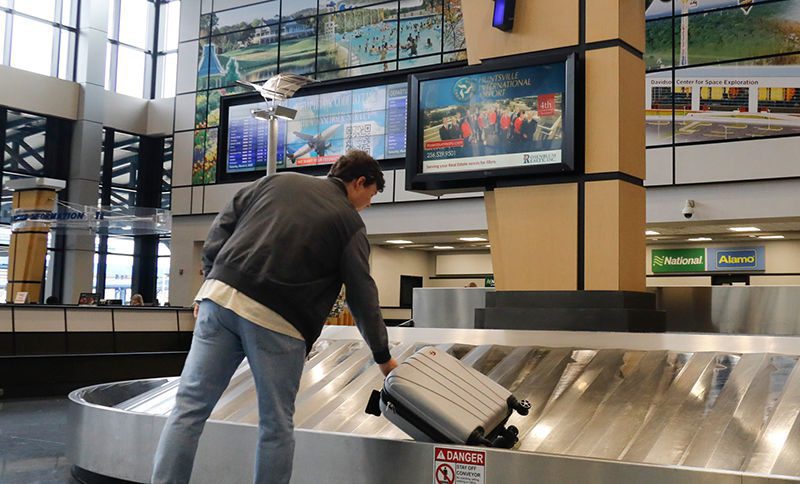
Digital displays are an important part of the airport’s signage strategy.
Flowers foresees two major benefits for HSV passengers when construction is completed. “First, the new edge-lit signs will light up the terminal and jump out at you. They will drastically change and modernize the overall appearance, while also improving the wayfinding experience,” he says.
“Second, the signage in our primary parking garage will be brighter and more user-friendly, making it much easier for people to get from their car to the terminal. We also are planning to build a second parking deck with 1,400 more spaces, and we will use the same signage for that structure as well.”

